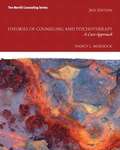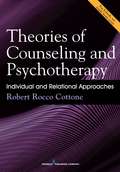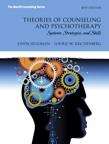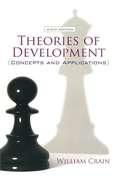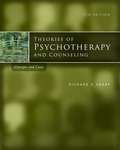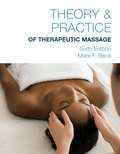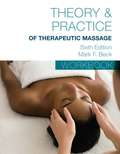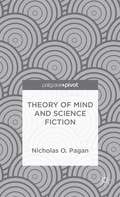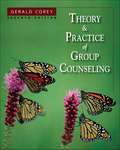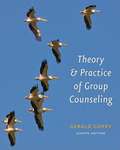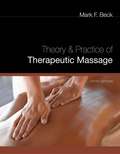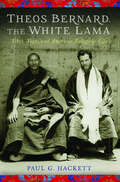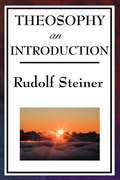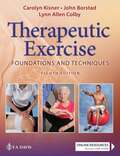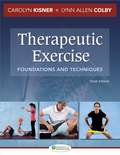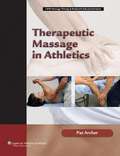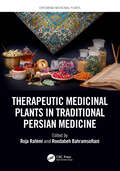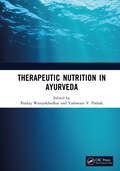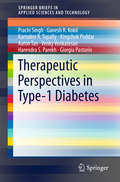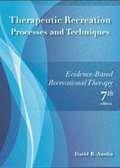- Table View
- List View
Theories of Counseling and Psychotherapy: A Case Approach (Third Edition)
by Nancy L. MurdockUsing case studies, applied examples, original source material, and her own inimitable pedagogical style, Nancy Murdock succinctly elucidates fifteen of the most influential and ground-breaking theories of psychotherapy and counseling. With this articulate guide to counseling theory, students will grasp complicated historical theory and not only understand the historical footing and uses of each, but will learn how these theories have informed each other and contributed to modern practice, while applying it to their own professional counseling experience. Examining the historical roots, evaluations, and lasting effects of Existential, Gestalt, Behavior, Cognitive, Reality, Feminist, Family, Narrative, and Solution-Focused Therapy and much more, this text equips students with the history and application necessary to bring theory to life. New Features Include: A New Chapter on Mindfulness Approaches Extensive Coverage of Ethics in Therapy Addition of Outcome and Theory-testing Research for Approaches to Therapy Coverage of Psychotherapy Outcome Research and Evidence-Based Treatment MyCounselingLab connects course content to video- and case-based real world scenarios, and provides: Building Counseling Skills exercises that offer opportunities for students to develop and practice skills critical to their success as professional helpers. Hints and feedback provide scaffolding and reinforce key concepts. Assignments & Activities assess students' understanding of key concepts and skill development. Multiple-Choice Quizzes help students gauge their understanding of important topics and prepare for success on licensure examinations.
Theories of Counseling and Psychotherapy: Individual and Relational Approaches
by Robert Rocco CottoneThis book focuses heavily on contemporary approaches and cross-professional applications and emphasizes "big picture" frameworks to conceptualize how major theories of counseling and psychotherapy operate and compare. This innovative new text presents theories using an "paradigm" framework: the organic-medical, psychological, systemic/relational, and social constructivist paradigms. Designed to be accessible and relevant to practice, the book enhances and reinforces learning with the inclusion of learning objectives, chapter summaries, applications of each theory in practice, and brief biographies of major theorists. The text moves beyond traditional approaches with expanded coverage of relationship-centered and post-modern theories such as Dialectic Behavior Therapy, Emotion Focused Therapy, Solution-Focused Brief Therapy, Narrative Therapy, and others. Each theory is explored in depth through the use of a student-mentor dialogue that examines and debates the challenges that arise with each theory. The book also addresses the counseling role in psychiatric case management, reflecting the growing reality of cross-professional collaboration. Practical yet rigorous, the text is a state-of-the-art introduction to contemporary approaches in counseling and psychotherapy for students in counseling, social work, professional psychology, marriage and family therapy, and related professions.
Theories of Counseling and Psychotherapy: Systems, Strategies, and Skills (Fourth Edition)
by Linda Seligman Lourie W. ReichenbergTheories of Counseling and Psychotherapy: Systems, Strategies, and Skills offers an innovative look at emerging and well-established counseling theories. Organizing theories into four broad themes (Background, Emotions, Thoughts, and Actions), authors underscore key similarities and differences in each approach. Moving beyond a traditional theories book, chapters include skill development sections that connect counseling theories with clinical practice. Fully revised, this edition brings a stronger multicultural focus, includes over 400 new research references, and offers new activities to sharpen clinical understanding.
Theories of Development: Concepts and Applications (6th Edition)
by William CrainThis text introduces students to twenty-four theorists and compares and contrasts their theories on how we develop as individuals. Emphasizing the theories that build upon the developmental tradition established by Rousseau, this text also covers theories in the environmental/learning tradition.
Theories of Hypnosis: Current Models and Perspectives
by Steven J. Lynn Judith W. RhueA survey of current theories of hypnosis along with relevant research.
Theories of Illness: World Survey
by George Peter MurdockTheories of Illness establishes a new landmark in comparative studies. Utilizing concepts from modern medicine and anthropological theory, Professor Murdock distinguishes the natural causes of illness from theories of supernatural causation. He subdivides the latter into theories of illness that are related to aggression (witchcraft, sorcery, and spirit aggression) and those which are related to guilt and a sense of sin (taboo violation and mystical retribution). Obviously, these relate to man's most basic beliefs as revealed in early religions.
Theories of Personality
by Lawrence Pervin Daniel Cervone John Oliver"Why should you take a course in personality? Why are some people so taken by the field that they decide to become personality psychologists? A basic attraction of the field is that it addresses the questions "Why are people the way they are? Why am I the way I am?" We are all fascinated by such questions, and personality psychology promises to answer them. Admittedly, this text and the scientific field it reviews may not definitively answer all of your questions. Yet much scientific progress has been made in understanding persons and the differences among them. This book will introduce you to some of the answers that contemporary scientific research can provide, while also introducing you to the best and most influential theoretical frameworks that have been developed for studying people." From Chapter 1
Theories of Psychotherapy and Counseling: Concepts and Cases (Fifth Edition)
by Richard S. SharfComprehensive in scope yet succinct in its descriptions and explanations, THEORIES OF PSYCHOTHERAPY & COUNSELING: CONCEPTS AND CASES, 5e equips readers with a solid understanding of the systematic theories of psychotherapy and counseling. The text delivers a thorough explanation of concepts as well as insightful case summaries and therapist-client dialogue that illustrate techniques and treatment in practice. It demonstrates how theories can be applied to individual therapy or counseling for common psychological disorders--such as depression and generalized anxiety disorders--as well as how to apply them to group therapy.
Theory & Practice of Therapeutic Massage, Sixth Edition
by Mark F. BeckTheory & Practice of Therapeutic Massage is full of invaluable knowledge and fundamental concepts for learning massage. The text also provides introductions into several areas within the profession, with chapters devoted to spa massage, lymph massage, clinical massage techniques, therapeutic procedure, athletic massage, and massage in medicine.
Theory And Practice Of Therapeutic Massage Workbook (Sixth Edition)
by Mark F. BeckThis Theory & Practice of Therapeutic Massage Workbook has been written to meet the needs, interests, and abilities of students, like you, receiving training In therapeutic massage. This workbook should be used together with Theory & Practice of Therapeutic Massage, Sixth Edition.
Theory Of Mind And Science Fiction
by Nicholas O. PaganTheory of Mind and Science Fiction shows how theory of mind provides an exciting 'new' way to think about science fiction and, conversely, how science fiction sheds light not only on theory of mind but also empathy, morality, and the nature of our humanity.
Theory and Practice of Group Counseling
by Gerald CoreyThis text outlines the basic elements of group process, deals with ethical and professional issues of group work, and overviews the key concepts and techniques of ten approaches to group counseling. This updated sixth edition emphasizes the practical applications of the theoretical models of group work, and encourages students to develop a synthesis of these approaches. There are two new chapters on stages of group development. Corey is professor emeritus of human services at California State University.
Theory and Practice of Group Counseling (8th Edition)
by Gerald CoreyWith the guidance of world-renowned counseling author, teacher, and practitioner Gerald Corey, best-selling Theory and Practice of Group Counseling, 8e equips readers with the knowledge and skills for effective group counseling and leadership. You'll learn key theoretical approaches to group leadership and how to successfully apply each in practice. With Corey's clear, straightforward writing style, you will have no difficulty understanding each theoretical concept and its relationship to group practice. And as you explore different approaches, your growing knowledge will enable you to integrate techniques from the various approaches you'll study in this book to create a unique approach that works successfully for YOU.
Theory and Practice of Therapeutic Massage (Fifth Edition)
by Mark F. BeckThe Theory and Practice of Therapeutic Massage (5th edition) is the classic text in the massage industry including the essential knowledge and skills needed to become a successful, professional massage therapist, plus the essentials of anatomy and physiology. Essential topics to the industry such as ethics, hygiene, communication skills, and body mechanics are discussed. Full-color illustrations and photographs clearly illustrate techniques and procedures. Classical massage is expanded with clinical techniques including neuromuscular and myofascial techniques, and lymph massage, combined to better serve the client by following therapeutic procedures. Numerous career tracts are explored including massage in a spa environment and athletic massage. A new chapter discusses massage for special populations including pre-natal, infant, elder, critically ill, people with cancer, and hospice. The final chapter has been revised to cover business practices for finding employment or successful self-employment.
Theos Bernard, the White Lama: Tibet, Yoga, and American Religious Life
by Paul G. HackettThe life and adventures of an American explorer and iconic figure in the 20th century religious counterculture movement.In 1937, Theos Casimir Bernard, the self-proclaimed &“White Lama,&” became the third American in history to reach Lhasa, the capital city of Tibet. During his stay, he amassed the largest collection of Tibetan texts, art, and artifacts in the Western hemisphere at that time. He also documented, in both still photography and 16mm film, the age-old civilization of Tibet on the eve of its destruction by Chinese Communists. Based on thousands of primary sources and rare archival materials, this is the real story behind the purported adventures of Bernard and his role in the growth of America's religious counterculture. Over the course of his brief life, Bernard met, associated, and corresponded with the major social, political, and cultural leaders of his day, from the Regent and high politicians of Tibet to saints, scholars, and diplomats of British India, from Charles Lindbergh and Franklin Delano Roosevelt to Gandhi and Nehru. Although hailed as a brilliant pioneer by the media, Bernard also had his flaws. He was an entrepreneur propelled by grandiose schemes, a handsome man who shamelessly used his looks to bounce from rich wife to rich wife in support of his activities, and a master manipulator who concocted his own interpretation of Eastern wisdom to suit his ends. Bernard had a bright future before him but disappeared in India during the communal violence of the 1947 Partition, never to be seen again.&“Well-written…A readable intellectual account of the life of an ambitious Tibetological pioneer.&”—Asian Ethnology
Theos Bernard, the White Lama: Tibet, Yoga, and American Religious Life
by Paul HackettIn 1937, Theos Casimir Bernard (1908–1947), the self-proclaimed "White Lama," became the third American in history to reach Lhasa, the capital city of Tibet. During his stay, he amassed the largest collection of Tibetan texts, art, and artifacts in the Western hemisphere at that time. He also documented, in both still photography and 16mm film, the age-old civilization of Tibet on the eve of its destruction by Chinese Communists. Based on thousands of primary sources and rare archival materials, Theos Bernard, the White Lama recounts the real story behind the purported adventures of this iconic figure and his role in the growth of America's religious counterculture. Over the course of his brief life, Bernard met, associated, and corresponded with the major social, political, and cultural leaders of his day, from the Regent and high politicians of Tibet to saints, scholars, and diplomats of British India, from Charles Lindbergh and Franklin Delano Roosevelt to Gandhi and Nehru. Although hailed as a brilliant pioneer by the media, Bernard also had his flaws. He was an entrepreneur propelled by grandiose schemes, a handsome man who shamelessly used his looks to bounce from rich wife to rich wife in support of his activities, and a master manipulator who concocted his own interpretation of Eastern wisdom to suit his ends. Bernard had a bright future before him, but disappeared in India during the communal violence of the 1947 Partition, never to be seen again.Through diaries, interviews, and previously unstudied documents, Paul G. Hackett shares Bernard's compelling life story, along with his efforts to awaken America's religious counterculture to the unfolding events in India, the Himalayas, and Tibet. Hackett concludes with a detailed geographical and cultural trace of Bernard's Indian and Tibetan journeys, which shed rare light on the explorer's mysterious disappearance.
Theosophy: An Introduction
by Rudolf SteinerA clear, concise explanation of human nature; the worlds of body, soul, and spirit; the laws of reincarnation; and the workings of karma.
Therapeutic Action: A Guide to Psychoanalytic Therapy
by Enrico E. JonesDiscusses the Q-sort method for quantifying and tracking progress in psychotherapy.
Therapeutic Exercise Foundations and Techniques
by John Kisner Carolyn Colby Lynn Allen BorstadThe premier text for therapeutic exercise Here is all the guidance you need to customize interventions for individuals with movement dysfunction. You’ll find the perfect balance of theory and clinical technique—in-depth discussions of the principles of therapeutic exercise and manual therapy and the most up-to-date exercise and management guidelines.
Therapeutic Exercise: Foundations and Techniques (Sixth Edition)
by Carolyn Kisner Lynn Allen ColbyThoroughly revised and updated throughout, Kisner & Colby's 6th Edition offers the most up-to-date exercise guidelines for individualizing interventions for those with movement disorders. Now with contributions from the leading experts in the field, it encompasses all of the principles of therapeutic exercise and manual therapy, including spinal surgery and spinal manipulation. This renowned manual remains the authoritative source for exercise instruction for the therapist and for patient self-management.
Therapeutic Massage in Athletics (Lww Massage Therapy and Bodywork Educational Ser.)
by Pat ArcherThis textbook on sports massage was created specifically for massage therapists, certified athletic trainers, and physical therapists who work with athletes. The author is an experienced massage therapy and athletic training educator and practitioner, and provides instruction on how to apply clinical massage techniques to athletes. The text is uniquely focused on the use and integration of basic sports massage, myofascial, neuromuscular, and lymphatic facilitation to enhance an athlete's performance potential and treat common athletic injuries and conditions. <P><P>The book includes numerous diagrams and pictures of techniques to help readers visualize specific concepts and procedures. From the Field Boxes contain quotes from professionals who practice sports massage. Case Studies present common athletic injury scenarios and descriptions of treatment protocols.
Therapeutic Medicinal Plants in Traditional Persian Medicine (Exploring Medicinal Plants)
by Roja Rahimi Roodabeh BahramsoltaniTraditional Persian Medicine (TPM) is one of the oldest medical doctrines, globally known due to pioneering physicians and scientists. The greatest source of natural medicines in TPM originates from medicinal plants. Therapeutic Medicinal Plants in Traditional Persian Medicine provides a background on the history of TPM, as well as an introduction to 40 of the most popular medicinal plants used in TPM. It is a practical guide for readers interested in medicinal plants used in the prevention, management, and treatment of different diseases.Features: Includes both traditional therapeutic applications and modern evidence/ uses Makes a comparison between preclinical and clinical studies Provides information on major chemical constituents, therapeutic uses, adverse reactions, and safety for each plant species A volume in the “Exploring Medicinal Plants” series, this book is a valuable resource for researchers, students, academicians, and scientists dealing witth medicinal plants, as well as for those interested in the fields of pharmacognosy, naturopathy, phytotherapy, and traditional medicines.
Therapeutic Nutrition in Ayurveda
by Yashwant V. Pathak Pankaj WanjarkhedkarNutrition remains the key to the successful treatment of diseases, in addition to the various evolved medical treatments across the world. The treatment outcome improves to a better extent with a degree of nourishment of the patients. Therapeutic Nutrition in Ayurveda (TNA) categorizes diseases system-wise and discusses nutrition with references from Ayurveda classics as well as publications from indexed journals in today’s world. This book emerges as a pilot project to discuss the clinical experiences directly and the concept of nutravigilance by experienced authors of respective specialties like hepatology, neurology, dermatology, ophthalmology, oncology, cardiology, gynecology, and so on. It broadly discusses diet and nutrition based on 12 different groups of diet in Ayurveda. Nutrition has been widely discussed for every disease dynamically in Ayurveda, with details of exclusion and inclusion of foods over a stipulated period or entire duration of treatment. Key Features: Presents system-wise and disease-wise therapeutic nutrition Includes clinical experience of physicians on therapeutic nutrition Contains interdisciplinary discussion on therapeutic nutrition with an integrated approach The integration of traditional and conventional health systems, along with the multidisciplinary approach, is the emerging trend for inclusive health care in the coming decades. This book serves as a handy guide for health care professionals across the continents, providing interdisciplinary correlations on nutrition.
Therapeutic Perspectives in Type-1 Diabetes
by Prachi Singh Ganesh R Kokil Karnaker R Tupally Kingshuk Poddar Aaron Tan Venky Venkatesan Harendra S. Parekh Giorgia PastorinThis book provides critical insights into and appraisals ofrecent breakthroughs in type 1 diabetes modulation, with a particular emphasison the potential impact of current prevention and treatment strategies. It alsodiscusses recent successes and failures in clinical trials. Presenting ancomprehensive overview of the disease, it is especially useful for newcomers inthe field. It also includes illustrations, which make it easy for the reader tograsp the basic concepts involved. Furthermore, the tables include concise andeasy-to-understand information on current clinical trials.
Therapeutic Recreation Processes & Techniques: Evidenced-Based Recreational Therapy
by David R. AustinIn fact, the subtitle, "Evidence-Based Recreational Therapy", has been added to emphasise the importance of evidence-based practice in recreational therapy. Today recreational therapists must possess a broad knowledge base that offers them a foundation for practice. This book explores how to practice recreational therapy yet provides theoretical and empirical evidence to support practice.
